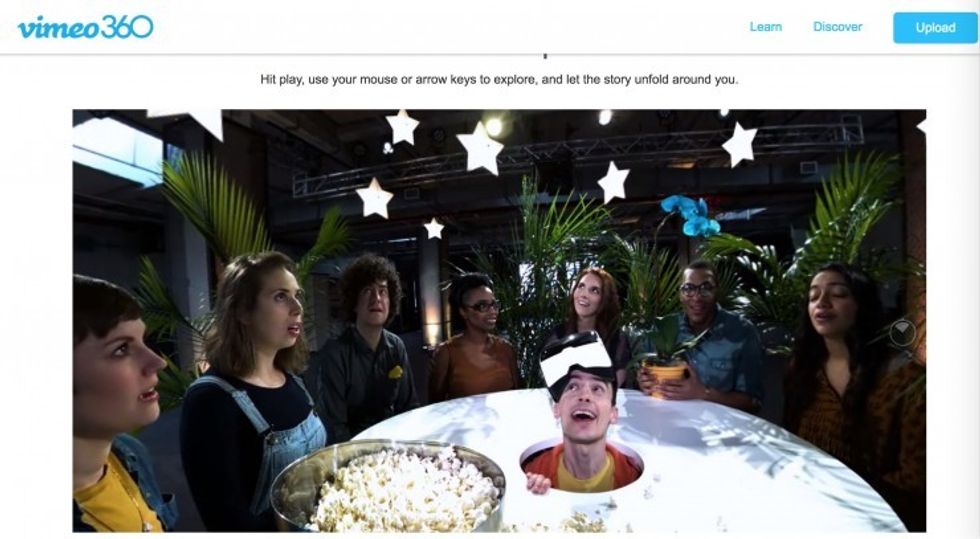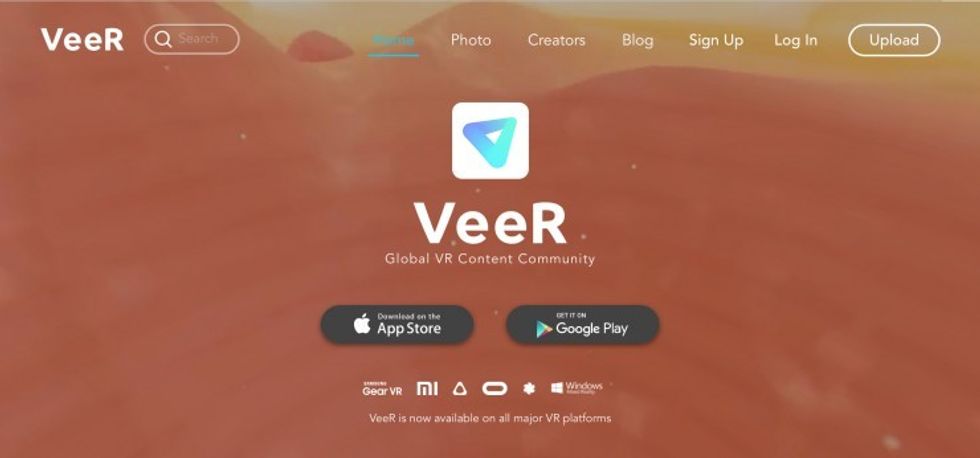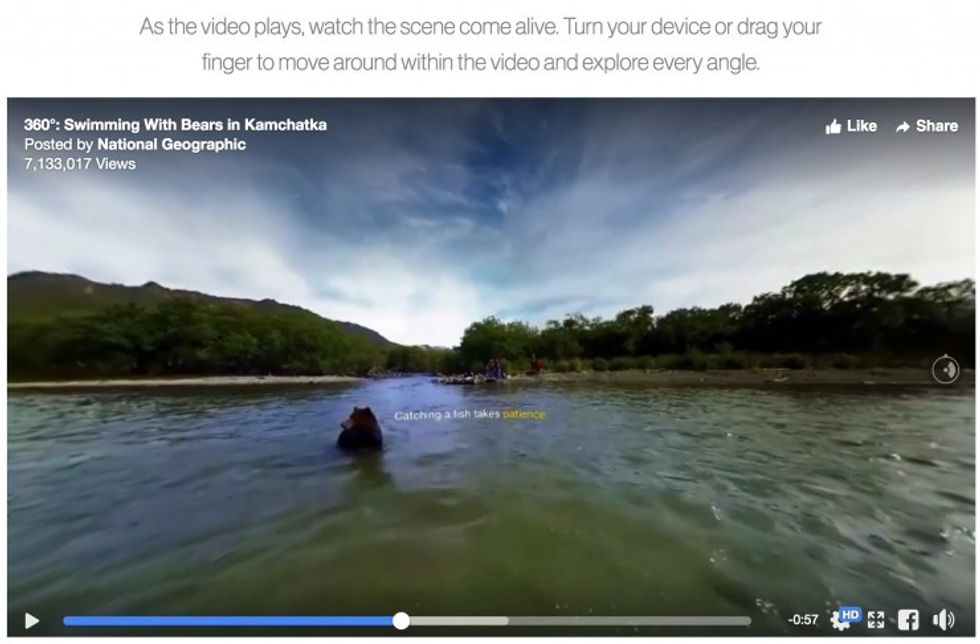The Top Five Places to Showcase Your 360° Videos
Looking for the best platform to publish your immersive videos? Here are the pros and cons of the top five.

As 360-degree cameras become more affordable and as more websites and apps begin natively supporting 360 photo & video playback, we thought we’d take a look at some of the best places to distribute your content. We compared the cost, ease of use, discoverability, maximum upload resolution, and overall user experience of each in order to let you evaluate what site (or sites) will make the best online home for your 360 content.
Vimeo 360
Usability & User Experience
Uploading your 360 content to Vimeo is as easy as uploading your traditional video content. Usually, the site will automatically detect content that was created in 360 format and whether that 360 content is mono or stereoscopic. If it doesn’t, you just need to check a box and your video will be served as a spherical 360 video. If you’re using Adobe Media Encoder, you can take advantage of its in-line publishing tools that allow you to render/transcode your footage and upload it to your Vimeo account (along with YouTube, Facebook, and others) in one motion which is really convenient. The recent social publishing options greatly reduce the need to upload multiple copies of your video to multiple destinations which increases the convenience factor considerably.
Vimeo’s 360 video upload process is familiar and intuitive, playback is predictably smooth, video quality is very good and Vimeo has always provided its users and visitors with a professional experience. If you’re already a Vimeo user then you’ll feel right at home uploading and hosting your 360 videos there. If you’re not a current subscriber, you’ll find the experience pleasant and high quality.
Discoverability
Vimeo has traditionally been a platform focused on providing high-quality video hosting for its subscribers who, then, typically embed their Vimeo hosted videos on their websites, and share direct links with clients. As such, the platform has never seemed as “discoverable” as sites like YouTube and Facebook. However, Vimeo recently introduced a social publishing option that will allow users to share the content they upload to Vimeo to both YouTube and Facebook natively (appears as if you uploaded your video directly to those sites vs sharing a link to your video on Vimeo) in the hopes that these native sharing options will incentivize content creators to make Vimeo their main video host.
Maximum Upload Resolution
Vimeo allows users to upload content as large as 8K. However, according to the website, playback is capped at 4K.
Cost
Vimeo does offer a free account option and there is no additional cost or charge specifically associated with Vimeo 360. However, to get the most out your Vimeo account, you’ll probably want to choose one of the subscriptions (ranging from $7-$50 per month) as uploading large 360 video files can eat up your free bandwidth allowance pretty quickly. Plus, Vimeo provides lots of great, professional features that are only available with paid subscriptions.
VeeR
Usability & User Experience
Navigating VeeR is very straightforward. For creators, files can be uploaded from desktop or mobile by clicking the upload button and following the prompts. As a consumer, you can find immersive photos and videos via a search box and by browsing categories. Additionally, you can follow your favorite creators and be notified when they upload new content. One sticking point I did notice was that playback stops and buffers more often than I’d like. This might be just growing pains of this new platform. I don’t think it should deter you and hopefully, its streaming solution will be more robust and responsive soon. The buffering is frustrating but if Veer can smooth that out, I think they’ll have a great platform.
Discoverability
VeeR is new and is specialized for a niche so it’s not nearly as ubiquitous as sites like YouTube and Vimeo. However, it has established itself early as a go-to site for immersive content. Unlike Vimeo and YouTube, Veer is exclusively dedicated to immersive content and, judging by search results, it already has attracted a large community. In addition, it is compatible with all consumer VR platforms which will help the platform get discovered as more consumers acquire VR headsets and begin searching for content. Veer seems like it has a lot of potential to become a major platform for immersive content.
Maximum Upload Resolution
There is no published resolution limit for Veer and its FAQ claims that there is no file size limit. The app does require a minimum resolution of 720p but that’s certainly not a constraint that professional filmmakers would have any problem with.
Cost
VeeR is free to join and to publish on.
Visbit
Usability & User Experience
Visbit offers free trial accounts so that you can get a feel for the workflow before you pay for a subscription. However, I didn’t have 12K footage to test with. As such, even though I can’t report directly on the usability from a creator’s standpoint, Visbit’s super high-res playback and the fact that it's (as of this writing) the only site out there offering such high-res streams made it worthy of inclusion in this list.
Watching ultra-high resolution immersive content in 2D and 3D streaming as smoothly as traditional “flat” 1080p videos do on YouTube is pretty impressive to be sure. It would be interesting to see what the upload/encode process is like. Considering that Visbit charges for the service of receiving, converting, and hosting video files while other platforms (Vimeo, YouTube, VeeR) do those things for free (albeit those sites have file size limitations and are not designed to stream ultra high-res videos) it would be interesting to see if they’ve got their process streamlined to the point that it justifies the subscription and processing fees.
Unless Visbit’s streaming protocol is proprietary and can’t be replicated, I suspect that, as technology continues to evolve, other major players will begin flaunting similar capabilities (for free) in the near future. So, while I think it’s pretty incredible to watch 8k 360, 3D streams with little to no interruptions, I’m not sure that alone will justify the costs.
Discoverability
Visbit is a brand new platform that is not at all ubiquitous. However, if you’ve just bought or received a new VR headset like an Oculus Go and are looking for content to download and watch, it probably won’t be long until you stumble on Visbit, download it, and watch your first 8 or 10K streamed 360 video.
Maximum Resolution
Visbit accepts 360 content up to 12K and streams it in up to 8K.
Cost
Visbit subscriptions for content creators and teams begin at $69/month and include:
- 10 8K-Mins for transcoding
- 60 8K-Mins for streaming/downloading
- Unlimited offline playback
- 1TB Cloud Storage
Overages:
- $5/8k-Minute for Transcoding
- $0.20/8k-Min for streaming/downloading
Facebook 360
Usability & User Experience
If you can upload a photo or video to Facebook, you can use Facebook 360. Simply upload a photo or video and check the box that says “this video is 360” and the app will display your photo or video interactively in 360 degrees. Furthermore, Facebook has published a variety of instructional, how-to videos to help you get started.
Uploading and watching 360 content on Facebook 360 is no different than uploading and watching traditional “flat” videos and so that part is easy. However, there is so little separation between regular old Facebook and “Facebook 360” (which is really just a curation of 360 photos and videos), it could prove confusing if you’re looking for a separate platform where you’d create a profile and upload content. That being said, the community support around Facebook 360 is quite good and there are plenty of video tutorials to help you get started creating content for distribution on the Facebook platform.
Discoverability
Facebook 360 brings with it the promise of tremendous discoverability for your 360 content for two reasons. First, over a billion people log onto Facebook every day. Secondly, because of its integration into Oculus and Gear VR headsets, Facebook answers new users who question, “what should I watch?” Thus, creators who establish themselves early will be able to build audiences before the competition for users’ attention gets overwhelming.
Maximum Resolution
Maximum upload resolution is 4096x4096 (4K).
Cost
Like the rest of Facebook, Facebook 360 is free for users and creators.
YouTube
YouTube really needs no explanation or introduction. We all know what YouTube is and how it works, and uploading 360 videos to YouTube works just the way uploading any other video does. The platform is probably one of the most discoverable video platforms in the world but that popularity comes with a trade-off: it’s hard to make your content stand out. But, it’s well established, has the technological backing and support of Google, it’s free, and everyone knows how to find it. So we think that no matter what other channels you choose to distribute your 360 videos on, YouTube will always be part of your strategy for showcasing your content.
Usability & User Experience
YouTube is one of the original video hosting platforms and is one of the easiest to use. Unlike some newer social, media-sharing platforms, even if you don’t know how to use it, people you know definitely do so there’s no shortage of help available. Using YouTube as a host for your 360 videos is no different than using it to host your flat, 2D videos. All you have to do is upload your content the way you would upload any other content, name it, tag it, publish it, and promote it.
As you likely know, it’s super easy to upload and manage your content to YouTube and it’s one of the most SEO-friendly and discoverable platforms out there. Additionally, you can monetize your content if you want to and, since YouTube is owned by Google, you can bet that the platform will continue to evolve, innovate, and adapt to changing needs and technology. It’s also safe to assume that YouTube will still be around in another five years. So for all those reasons, YouTube is a tried & true home for all your video content (including immersive content).
However, YouTube has developed a reputation as not being the most professional platform for hosting your content and directing clients to for viewings. For that reason, lots of filmmakers upload to both Vimeo and YouTube. The former for presentation, and the latter for discoverability. That all still holds true for 360 content. You might want to upload to both, and especially now that Vimeo allows you to natively publish your Vimeo-hosted videos to YouTube, there’s really no reason not to do that.
Discoverability
YouTube is world’s largest platform for video publication on the web and, because it’s owned by Google, videos found on YouTube are among the most easily discovered in search engine queries and that makes the potential traffic that your YouTube-hosted 360 video will receive larger than other sites. Of course, in the real world, you’re competing with billions of other videos and that’s a lot of noise to cut through. Differentiating your content on YouTube is one of the largest challenges of using the platform.
Cost
YouTube is a free platform.
Conclusions
It’s hard to crown a champion in this race. It seems to still be the case that there’s no “one place” for publishing content. The best strategy will most likely involve several platforms —some for discoverability, others for presentation. With 360 content creation becoming more democratized, there are a variety of platforms vying for your content and for the attention & traffic that new content will bring to those platforms.
We recommend that you review each site's offerings and then decide what works best for your workflow, clients, and audience. For example, maybe it makes sense to embed crazy high-res streams from Visbit in your website, show client previews on Vimeo (to save on bandwidth charges from Visbit), and syndicate your Vimeo posts to YouTube and Facebook for discoverability—all while keeping an eye on what VeeR is doing as they could in become a major player in online immersive content.
Know of any great immersive video hosting platforms? Post links in the comments!
Featured 360° image courtesy of BerCo Aerial.




















